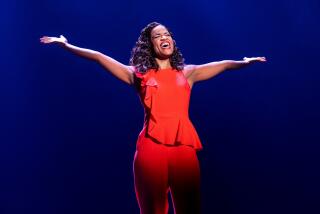From the archives:: Bob Hope on the war years, Broadway and working with Bing Crosby
- Share via
In 1991, Times staff writer Susan King interviewed Bob Hope about his career. This article was originally published Dec. 15 of that year.
Where there’s Christmas, there’s Hope. Bob Hope, that is.
The legendary comedian and goodwill ambassador stars in Wednesday’s “Bob Hope’s Cross-Country Christmas,” the latest edition of his annual NBC yuletide special.
Hope, who has been with the Peacock Network for 54 years, has celebrated the holidays with TV audiences since 1957.
Guests in the one-hour special include Macaulay “Home Alone” Culkin, country-music star Reba McEntire, Miss America 1992 Carolyn S. Sapp and the Associated Press All-America Football Team.
Taped earlier this month at the landmark Broadmoor Hotel in Colorado Springs, Colo., and at the Grand Ole Opry in Nashville, “Bob Hope’s Cross-Country Christmas” features Hope performing “Silver Bells” with his wife, Delores, in the Rockies. The special also marks the 50th anniversary of Hope’s performances for U.S. troops abroad and at home.
The British-born Hope took Broadway by storm in the 1930s in such musicals as “Roberta” and “Red, Hot and Blue” and made his feature film debut in “The Big Broadcast of 1938,” in which he introduced his Oscar-winning signature song “Thanks for the Memory.” One of the biggest box-office stars in the ‘40s and ‘50s, Hope was featured in such films as “The Cat and the Canary,” the “Road” pictures with Bing Crosby, “Seven Little Foys” and “Beau James.”
Still an avid golfer at 88 -- he was planning to hit the golf course after this interview -- Hope talked about comedy, his career and his “Cross-Country Christmas” over lunch at his Toluca Lake home with TV Times staff writer Susan King.
“Bob Hope’s Cross-Country Christmas” marks your 50th anniversary of performing for U.S. soldiers. How did you get involved in performing for the troops?
It happened around April [1941]. I was doing my [radio] show at NBC, and the producer said they want you down at March Field. I said, “March Field? Where is that?” He said, “That’s an Air Force base in Riverside. They want you to come down and do the show down there. They would love you.”
And so I found myself on a bus with Frances Langford and Jerry Colonna and we go right down there to March Field and the audience was so sensational. So the next week we booked Camp Pendleton and we went down to the San Diego Naval Base and we kept doing these shows.
Then, in December, war started and then it became dramatic. For five straight years we went all over the world ... wherever we had troops. We would take any star we could or some gals. It was something.
We didn’t go any place they warned us about [being dangerous], believe me. [He laughs.] We were too cowardly. But the first trip we took up to Alaska, we played a little place called Cordova, where we had some troops. After the show we got in the plane to go to Anchorage because [a general] was holding a street dance in our honor. We got up in the air and ran into a storm and then our radio went out. We were over Anchorage in a storm. Those mountains are about 12,000 or 13,000 feet. We were going around wondering what we were going to do. A United airliner felt our backwash and went down and told the general and he put up the anti-aircraft lights and we got in. That was the first trip.
Has humor changed over the past 50 years?
Not much changes. [Servicemen] laugh at all the topical events. They love the girls.
Everyone knows you introduced the song “Thanks for the Memory,” but didn’t you also introduce the Cole Porter standard “It’s De-Lovely” on Broadway?
Yeah, with [Ethel] Merman. There was always one hit song in a show. When we did “De-Lovely,” we did four encores.
Did you ever think of going back to Broadway?
I had a couple of offers, but I got lucky after my third picture, “The Cat and the Canary.” I turned into box office. When “Cat and the Canary” came out (people) started running into the theaters. Then Paramount ran over to my dressing room with a contract for seven years. So I signed up for seven years.
Did you and Bing Crosby have any idea when you did “Road to Singapore” in 1940 that it would spawn five sequels?
No, and we didn’t care. We used to do anything [for a laugh]. After about a week, the director, Victor Schertzinger, went into the commissary and sat down at the table and said, “I got the easiest job. All I have to do with these guys is say, ‘Start.’ But I don’t want to say ‘Stop.’ ” We were always concocting something. I had my set of writers and Bing had a set working for him and we used to come up with new little slants all the time. It was fun.
You’ve worked with such glamorous leading ladies as Paulette Goddard, Madeleine Carroll, Dorothy Lamour, Lana Turner, Eva Marie Saint and Katharine Hepburn in the movies. Is there an actress you wanted to work with in a film but never got the opportunity?
Sure there is ... I never heard from Bo Derek.
I bet retirement is a dirty word to you. But do you think you’ll ever retire?
Not as long as I feel good. It is too much fun. God, you have fun just doing things with people. You have fun writing. ... It keeps your mind alert and keeps you thinking.
More to Read
Only good movies
Get the Indie Focus newsletter, Mark Olsen's weekly guide to the world of cinema.
You may occasionally receive promotional content from the Los Angeles Times.











